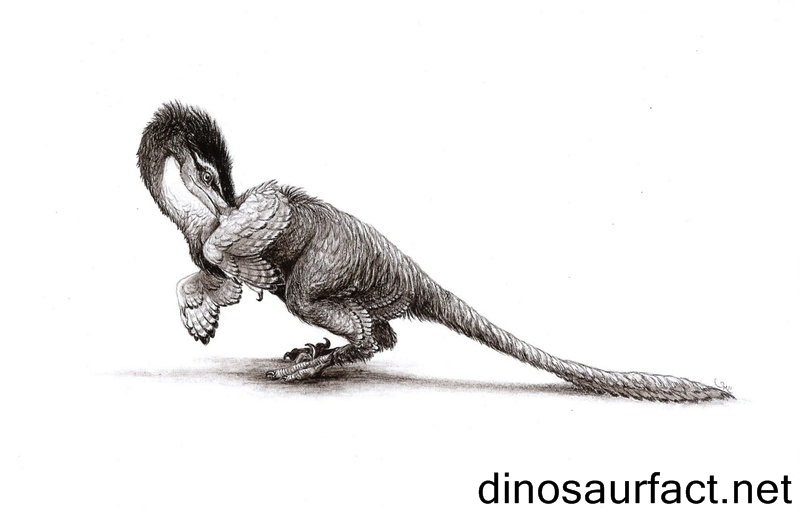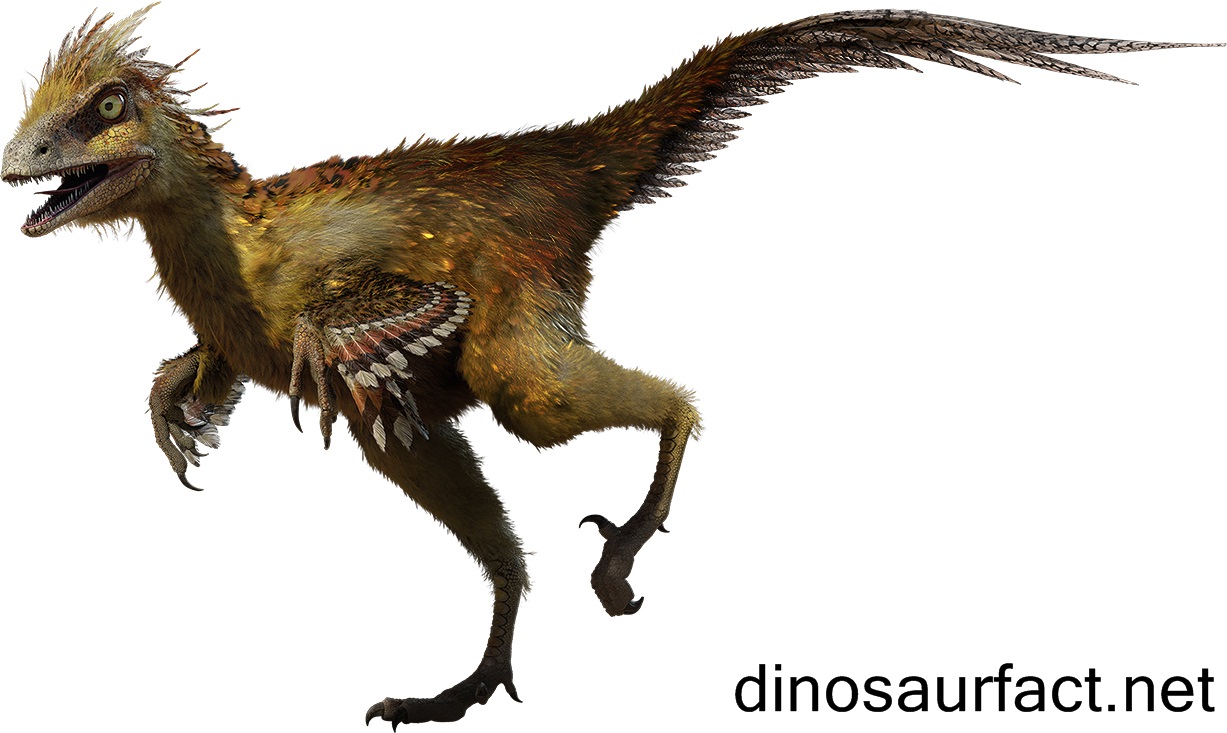 Click to visit the previous dinosaur bio
Click to visit the previous dinosaur bio
 |
|
 |
|
Kingdom: Animalia
Phylum: Chordata
SuperOrder: Dinosauria
Order: Theropoda
Family: Dromaeosauridae
Genus: Hesperonychus
 |
|
 |
|
 |
|

Introduction
The Hesperonychus was an extremely small dinosaur that existed on the earth in the late Cretaceous Period of the Mesozoic Era. It belonged to the dromaeosaurid group of dinosaurs and was related to the Velociraptor. It is the smallest known North American meat eating dinosaur. One would expect the compsognathids to clinch that title; the Compsognathus was displayed in the movie ‘The Lost World’ quite prominently; but this was not to be. The Albertonykus was smaller than the Hesperonychus, but it likely predated exclusively on termites and hence cannot be termed as a carnivore.
The time period of existence of this dinosaur is estimated to be around 75 to 80 million years, an era that lies in the Campanian age of the Cretaceous. It preceded the Velociraptor by about 5 million years. Incidentally, the Velociraptor was an Asian dinosaur, as was the other small raptor, the Microraptor. North America had had a strange dearth of small dromaeosaurid fossils till the discovery of the Hesperonychus. The Deinonychus was possibly the smallest raptor of North America, and it was almost three times the size of the Velociraptor. The discovery of the Hesperonychus filled this niche.
The length of this dinosaur was less than 1 meter and its weight was about 1.8 kilos. Its remains were found in Canada.
Etymology
The name Hesperonychus has Greek origins. The prefix ‘hesperos’ is the Greek word for ‘western’ and the suffix ‘onychus’ is derived from the Greek word ‘onxy zoou’ which roughly means ‘claw’. Thus the name of this reptile roughly translates to ‘the western claw’. Since the Hesperonychus was one of the first small raptors discovered in the western world, it was named so. Dromaeosaurids have a distinctive claw one of the phalanges of their hind legs and they are generally named for it.
The second half of the binomial name, the H. elizabethae, was chosen to honor the paleontologist Elizabeth Nicholls, who discovered the dinosaur in 1982.
The nomenclature of the remains was done by scientists Phil Currie and Nick Longrich in 2009.
Discovery and nature of fossils
The remains that are currently attributed to genus Hesperonychus were discovered almost three decades before they were described. They were found by Dr. Elizabeth Nicholls near the Dinosaur Provincial Park of Alberta in Canada. They were found south of the Red Deer River, about 12 miles away from the Park.
Nicholls was the curator of the Tyrrell Museum and kept them in one of the drawers of the facility, only to be forgotten.
They were fortuitously found lying in the storage drawer by Longrich and Currie in 2007 ansd were described in 2009.
The holotype consisted of only a partial pelvic girdle. The size of the pelvis was small, but the bones were fused together, indicating that they belonged to an adult specimen.
The Tyrrell Museum also has a few undescribed small phalanges, which contain the sickle claw. These are believed to belong to a Hesperonychus specimen.
Despite of this scarcity of fossils, Longrich and Currie described the dinosaur based on comparisons with other dromaeosaurids.
Classification
The Hesperonychus is classified under suborder Theropoda, family Dromaosauridae and clade Microraptoria. This classification was decided upon by the analysis of other dromaeosaurids and microraptorians.
The youngest known microraptorian up until the time that the Hesperonychus was described was the Microraptor. And it had existed some 125 million years ago in the Aptian age of the Cretaceous and its fossils were discovered in China. The discovery of the Hesperonychus proved that microraptors were present on the earth as late as the 75 million years ago, about 50 million years ahead of what was previously believed.
Furthermore, the Hesperonychus was discovered in North America, showing that such dinosaurs were indeed present there. It is possible that the North American terrain just did not preserve smaller dinosaurs well.
Only a single type species has been described till today.
Physical features
Although the Hesperonychus is only known from a partial pelvis, its length is calculated to be about 90 cms and its weight was about 4 pounds. The length also takes into account the tail of this dinosaur.
It is unknown whether this dinosaur possessed feathers. Its relative, the Microraptor had iridescent feathers and most scientists believe that so did the Hesperonychus.
The hind legs of this dinosaur contained the sickle claw of the raptors that did not touch the ground while it walked.
It is unlikely, though not impossible that the Hesperonychus could fly. The Microraptor has possessed special adaptations for gliding, but Longrich and Currie believe that the Hesperonychus more closely resembled the Sinornithosaurus, which could glide only for short distances.
Habits and habitat
The Hesperonychus was a bipedal reptile. It is difficult to say whether it was terrestrial or arboreal.
Dromaeosaurids were believed to be intelligent dinosaurs and the Hesperonychus was more derived amongst the group, hence likely intelligent too.
It is believed that this reptile possessed a keen sense of smell, just like the Velociraptor. Its feeding manner may have been similar to the Velociraptor also.
The diet of the Hesperonychus possibly consisted of small mammals and smaller reptiles if it possessed small and sharp teeth like the Velociraptor. Although it was very small in size, it was still larger than the Cretaceous mammals.
It is likely that this dinosaur possessed a keen eyesight and used it to capture its prey, much like other dromaeosaurids.
Paleontologists believe that if the Hesperonychus possessed feathers, it could have used them to brood eggs, similar to modern day birds.
Its habitat consisted of small woodlands consisting of marshes, swamps, and other small water bodies.
Related and coexisting species
The Hesperonychus was related closely to the Tianyuraptor, Microraptor and the Sinornithosaurus. It was distantly related to the Velociraptor and the Dromaeosaurus. It possibly shared its environment with dinosaurs like the Edmontonia, Chasmosaurus, Centrosaurus and Gorgosaurus. It likely hunted the Eodelphis, a small mammal that lived in North America at about the same time.
The concluding notes
Scientists have long speculated that the Cretaceous mammals were not allowed to grow larger due to dinosaurs like the Hesperonychus. But Currie and Longrich have a different perspective to the issue. They contemplate dinosaurs could not become smaller due to the niche environments being occupied by mammals. Their large size was possibly one of the reasons for the extinction of the dinosaurs after the Cretaceous Paleogene extinction event.
Index
Extinct Profiles
 Triassic Dinosaurs
Triassic Dinosaurs Jurassic Dinosaurs
Jurassic Dinosaurs Cretaceous Dinosaurs
Cretaceous Dinosaurs Pterosaurs
Pterosaurs Marine Reptiles
Marine Reptiles Dinosaur Extinction
Dinosaur Extinction